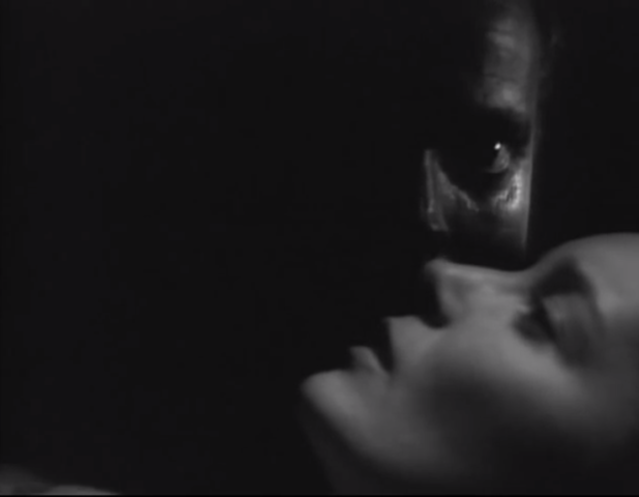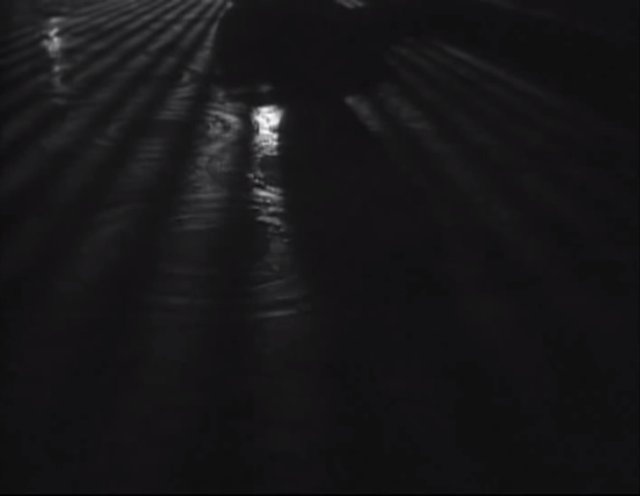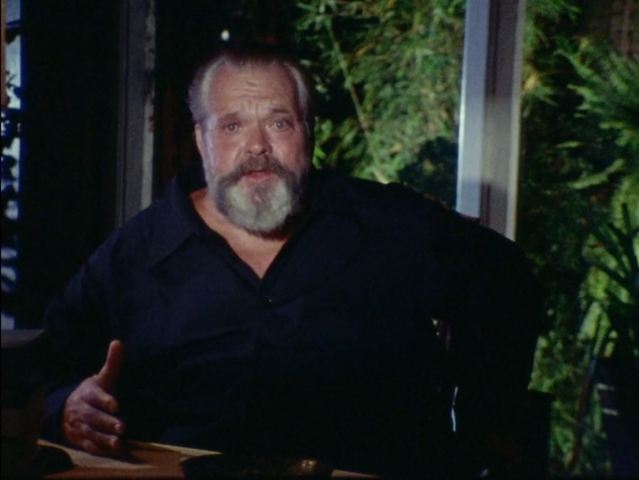
Welles as Othello, and MacLiammoir as Iago
I waited a long time to finally watch Orson Welles’s Othello, in order to see it in fully restored glory on Criterion’s new Blu-ray release. Othello is the second of three great Shakespeare adaptations that Welles created, between Macbeth and Chimes at Midnight. Whereas Macbeth was created on the low budget studio lot of Republic Pictures, and filmed rapidly in under a month, Othello was filmed almost entirely on locations in Europe and Africa, and was to take over 3 years to complete filming and post-production. Very different sets of difficulties presented themselves in making a studio picture versus an essentially guerrilla-style independent film, but the result was to be the harbinger in many ways of developments in his style that would result in films as varied as Mr. Arkadin and his later masterpieces The Trial, Touch of Evil, and Chimes at Midnight. While it does not reach the heights of that latter trio of films, it is nonetheless a worthy visual meditation on the core of Shakespeare’s great tragedy.
I say, “visual meditation,” because what is most striking about this version of Othello is not the power of the poetry (as one might expect from the gifted orator Orson Welles), but the primarily the power of the imagery. In scene after scene, Welles takes us through the emotional core of Shakespeare’s story, while taking out many of its most celebrated (and also its most controversial) lines. Despite being forced to piece together a patchwork of shots filmed literally across thousands of miles and years apart, there is a remarkable visual consistency, and a thematic unity to the black-and-white imagery. I cannot disagree with Welles scholar James Naremore, who wrote, “Of all Welles’s films, Othello is the one for which the adjective ‘beautiful’ is most justified.”

Beauty and the Betrayed
Much has been written and discussed about the fact that Welles’s editing of the play takes out much of the specifically racial element that is present in the original text. To be sure, Welles’s Othello is still a black man, and Welles is still a white man playing a black man, in blackface makeup. But the removal of certain key lines regarding Othello’s blackness, present in Shakespeare’s play, brings the focus of the narrative to Iago’s (Michael MacLiammoir) deception and betrayal of Othello, and to Othello’s jealousy towards his wife, Desdemona (Suzanne Cloutier).
To return to the visual aspects of the film, it seems that the stylistic choices in terms of editing and camera work were possibly necessitated by the chaotic nature of the filming process. But the result was a work both in continuity with his earlier studio efforts, and a break from them as well. While he did do documentary-style filming on the aborted anthology film, It’s All True (the extant parts of which I have not yet seen), and there was a good deal of location shooting on The Lady from Shanghai, he did not do anything like the degree of location work involved in Othello. The Lady from Shanghai also, while notably fragmented in the cutting and the visual motifs, does not seem to approach the sheer number of individual shots employed in Othello. Despite this, Othello is far less narratively convoluted, probably in part because Welles was starting from an impeccable original script, and functioning more as an editor than as a writer.
Othello breaks with what is often thought of as one of Welles’s trademark visual elements: the long take. The longest unbroken take is a key scene of dialog between Othello and Iago (see first image above), where Iago most clearly lays out Desdemona’s supposed infidelity to the moor. This shot is less than 2 minutes long, which in Wellesian terms is hardly long at all. Of course Welles would make the most famous long take of all in the opening shot of his next studio film, Touch of Evil, but those elaborate shots require the technical expertise and control of a studio setting. Othello has more in common with its immediate successor, Mr. Arkadin, in terms of visual style, which is unsurprising given the lack of Hollywood apparatus and personnel in that film as well. Without the controls they afforded, he was in “guerrilla-filming” mode. Picking up shots as he could in various locales when money and opportunity was available, Welles had to create a different film grammar for his story. It’s at times dazzlingly choppy, but never unclear. The post-dubbed soundtrack is often out of sync with the visuals, or is difficult to hear, but this further emphasizes that at some point, Welles’s film becomes less a movie version of Shakespeare’s play, and more a motion picture meditation upon the source material. It almost works more like a silent film, though there is much more (and faster paced) shot-reverse shot editing than I believe you would typically find in a silent film. After I made this observation, I found that Peter Bogdanovich and Myron Meisel both made similar comments about the relation of this movie to silent pictures on the Criterion disc commentary.

Expressionistic shadows throughout this film, especially with the recurring “bars/nets” motif.
The music in the film is also startling in its effect. Composed primarily by Francesco Lavagnino, it is (again, as Myron Meisel has pointed out on the commentary track) a deft blending of medieval/renaissance sounds and a fairly avant-garde midcentury European sound. The result is perfect in uniting the quasi-historical setting of the play, and the effect of universality evoked by this geographic liberties and expressionistic filming of the production design. Not enough has been written about the use of music in Welles’s films, but for an overview, including some comments on Othello, I recommend this article from the New Yorker by Alex Ross, written a couple years ago for Orson Welles’s centenary.
As has been noted, Othello stands in between Welles’s other two Shakespeare films in his filmography, and it is interesting to explore the ways in which the three differ in their approach to film grammar and production design. Macbeth (1948) has a highly artificial look, in part probably due to the budget, but also by design. The images have an almost graphic quality, where the handmade, painted look of a stage production is in evidence. Welles criticized the Shakespeare films of Olivier for being merely filmed stage plays, but he was not a hypocrite in this judgment. Welles’s Macbeth still remains strongly cinematic despite the limitations of the set used for filming. In Othello, the use of such a variety of castles and battlements as film locations creates much more varied types of shots, despite an essential unity in the motifs of grates, arches, and waterways. By the time Welles got to make Chimes at Midnight (1965), he seems to have been able to integrate these two approaches, again through a combination of intentional design and the innovations imposed by necessity. Chimes at Midnight contains many more elaborate setups and camera moves, particularly in the cleverly designed tavern set. But it also contains some of the masterful editing that distinguishes Othello from most of his previous work, as in for example, Chimes‘s celebrated battle sequence.
As for other distinctly Wellesian visual traits, there are several key shots employing a deep focus, or enlarged depth of field. But there are also notable departures from that style, particularly in some soft-focus closeups. What I would note as a consistent visual theme in most of his work, even back to Citizen Kane, is visual representation of the grotesque, which is certainly on display here. Welles is also famous for his use of mirrors, also beginning with Kane, and in Othello there is a fantastic use of a curved mirror, which distorts the view of Othello as he looks at Iago and later Desdemona.

Welles was the original master of the “cold open.”
In terms of the narrative structure, Welles stuck to his favorite framing device: beginning at the end of the story, then telling the events through a flashback. The first image of the film is of the dead Othello, resting on a funeral bed, his head inverted by the angle of the camera. This is more or less the same image which begins The Trial, as well, following that film’s prologue. The flashback structure which worked so well for Welles was used in almost every one of his narrative films, and arguably in F for Fake as well. James Naremore relates that he even attempted to use the same structure in The Stranger as well, but the final version was altered from his intended form.
I will leave it to other, more knowledgeable writers to discuss the racial issues in Othello, both in the play, and in the way that Welles’s redactions alter the emphasis on that element. I highly recommend Professor Ayanna Thompson’s discussion on the Criterion Blu-ray for a brief, but thorough historical overview, which provides context for the depiction of blackness in Shakespeare through the centuries.
Since this discussion has turned into almost a review of Criterion’s now-definitive edition of Othello, I might as well mention that two more supplements on the second disc are quite exceptional for Welles fanatics. The documentary, Souvenirs d'”Othello”, is a long interview from 1995 with Suzanne Cloutier (Desdemona) in which she discusses not only the production of Othello, but also her long friendship with Orson Welles. Among other things, I learned here that it was she who helped Welles procure the financing from the brother-in-law of the Shah of Iran for his late, as-yet-still-unfinished film, The Other Side of the Wind.

Besides his well known wine commercials, Orson Welles made a handful of generally well-regarded motion pictures.
Of even more direct interest is the inclusion of Welles’s final completed film, the made-for-TV essay Filming Othello. It employs a less bravura style than F for Fake, but has certain similarities as well to that film as well, in particular the device of watching his own interviews on a moviola editing machine. In any case, there is little more satisfying to me than listening to Orson discourse on a subject he is passionate about: to wit, Shakespeare and his great, enduring play Othello.
This post is part of the Blind Spot 2017 series, hosted by Ryan McNeil at The Matinee.


Lots of great points here. I saw this on TCM earlier this year (I’m not sure if it would have been the same restoration on the Criterion disc or not), and I was really struck by the visuals. Admittedly, I’ve never read Othello or seen it performed, so even though I knew the basic premise, I found that it helped to look up a plot summary — some of the dialogue either went by too fast or was difficult to hear, which, as you’ve said, made the visuals seem all the more important.
LikeLiked by 1 person
Thanks, Erin. Something I didn’t discuss is that there are several different versions of the film. The two versions that Welles supervised and released are both included on the Blu-ray. There’s also the “restoration” done in the 90s that was controversial for its reframing of the image and rerecording of the music soundtrack. I wonder which you saw.
LikeLiked by 1 person
Yes, I read about that after I watched the movie. I’m thinking I might have seen the 90s “restoration” — I seem to remember seeing Beatrice Welles’s name on it — but I may be wrong about that. There’s an article on TCM’s website that implies that that one is the definitive version (saying it “was finally complete with the power and beauty he had always intended”), so that’s probably the version they show.
LikeLiked by 1 person
Yeah I think that’s what your saw. With all respect to Beatrice Welles, it’s clear that the new Criterion restorations are the definitive ones. I’m sure they meant well, but it seems like one of many misguided attempts at “improving” an older film which occurred in the 90s.
LikeLiked by 1 person
That’s the impression I’ve gotten from everything I’ve read (not that I’ve read much). I’ll definitely have to check out the Criterion at some point.
LikeLike